A Design of Real-Time Data Acquisition and Processing System for Nanosecond Ultraviolet-Visible Absorption Spectrum Detection
Abstract
:1. Introduction
- An oversampling method that is suitable for the CMOS sensor’s output is proposed. Following the moving average, filtering is performed on the low-frequency component to filter out the residual spectrum noise in the low-frequency components of the spectrum signal;
- The parameters of the filter are set adaptively by evaluating the spectral resolution of the CMOS spectrophotometer system, and the frequency-domain analysis for the spectrum data is used to avoid the problem of insufficiently clean filtering or the destruction of spectrum details as a result of fixed parameter settings;
- The implementation of the filter on the FPGA is optimized by using a pipelined structure and dual high speed first-in-first-out (FIFO) random access memory (RAM) to match the high rate of speed of the CMOS sensor output in an in situ measurement application. As a result, the CMOS linear image sensor successfully captures the spectrum of the xenon flash light. Meanwhile, oversampling and filtering algorithms are implemented in real time.
2. Materials and Methods
2.1. Experimental Setup
2.2. Moving-Average Filter Design for the Spectrum Data
2.3. Implementation on the FPGA Board
3. Results
3.1. System’s Working Performance
3.2. Determination of the Filter Parameters
3.3. Noise Evaluation for the Spectrum of Xenon Flash Light
3.4. Signal Quality Evaluation for Absorption Spectrum
4. Discussion
Author Contributions
Funding
Institutional Review Board Statement
Informed Consent Statement
Data Availability Statement
Acknowledgments
Conflicts of Interest
References
- Li, S.; An, Y. Statistics of environmental events in China during the period from July to August in 2015. J. Saf. Environ. 2015, 15, 390–394. [Google Scholar]
- Li, Z.H.; Jia, J.J.; Wu, Y.S.; Zong, H.B.; Zhang, G.A.; Wang, Y.P.; Yang, Y.; Zhou, L.; Gao, S. Vertical Distributions of Suspended Sediment Concentrations in the Turbidity Maximum Zone of the Periodically and Partially Stratified Changjiang Estuary. Estuaries Coasts 2019, 42, 1475–1490. [Google Scholar] [CrossRef]
- Zhang, W.L.; Lei, M.T.; Li, Y.; Wang, P.F.; Wang, C.; Gao, Y.; Wu, H.N.; Xu, C.; Niu, L.H.; Wang, L.F.; et al. Determination of vertical and horizontal assemblage drivers of bacterial community in a heavily polluted urban river. Water Res. 2019, 161, 98–107. [Google Scholar] [CrossRef] [PubMed]
- Gong, J.; Ran, Y.; Zhang, D.N.; Chen, D.Y.; Li, H.Y.; Huang, Y.D. Vertical profiles and distributions of aqueous endocrine-disrupting chemicals in different matrices from the Pearl River Delta and the influence of environmental factors. Environ. Pollut. 2019, 246, 328–335. [Google Scholar] [CrossRef] [PubMed]
- Pons, M.-N.; Assaad, A.; Oucacha, C.; Pontvianne, S.; Pollier, B.; Wagner, P.; Legout, A.; Guérold, F. Nitrates monitoring by UV–vis spectral analysis. Ecohydrol. Hydrobiol. 2017, 17, 46–52. [Google Scholar] [CrossRef]
- Hu, Y.T.; Wen, Y.Z.; Wang, X.P. Detection of Water Quality Multi-Parameters in Seawater based on UV-Vis Spectrometry. In Proceedings of the Oceans 2016—Shanghai, Shanghai, China, 10–13 April 2016. [Google Scholar]
- Carter, H.T.; Tipping, E.; Koprivnjak, J.F.; Miller, M.P.; Cookson, B.; Hamilton-Taylor, J. Freshwater DOM quantity and quality from a two-component model of UV absorbance. Water Res. 2012, 46, 4532–4542. [Google Scholar] [CrossRef] [Green Version]
- Langergraber, G.; Gupta, J.K.; Pressl, A.; Hofstaedter, F.; Lettl, W.; Weingartner, A.; Fleischmann, N. On-line monitoring for control of a pilot-scale sequencing batch reactor using a submersible UV/VIS spectrometer. Water Sci. Technol. 2004, 50, 73–80. [Google Scholar] [CrossRef]
- Wu, D.; Wei, B.; Tang, G.; Feng, P.; Tang, Y.; Liu, J.; Xiong, S. Turbidity Disturbance Compensation for UV-VIS Spectrum of Waterbody Based on Mie Scattering. Acta Opt. Sin. 2017, 37, 0230007. [Google Scholar]
- Østergaard, J. UV/Vis Spectrophotometry and UV Imaging. In Analytical Techniques in the Pharmaceutical Sciences; Müllertz, A., Perrie, Y., Rades, T., Eds.; Springer: New York, NY, USA, 2016; pp. 3–27. [Google Scholar]
- Tian, P.; Qin, Y.H.; Zhao, L.; Mutisya, S.M.; Jin, J.H.; Lu, J.Q.; Hu, X.H. Multiparameter Spectrophotometry Platform for Turbid Sample Measurement by Robust Solutions of Radiative Transfer Problems. IEEE Trans. Instrum. Meas. 2021, 70, 6003110. [Google Scholar] [CrossRef]
- Hutchison, C.D.M.; Parker, S.; Chukhutsina, V.; van Thor, J.J. Open hardware microsecond dispersive transient absorption spectrometer for linear optical response. Photochem. Photobiol. Sci. 2022, 21, 23–35. [Google Scholar] [CrossRef]
- Fossum, E.R.; Hondongwa, D.B. A Review of the Pinned Photodiode for CCD and CMOS Image Sensors. IEEE J. Electron. Devices Soc. 2014, 2, 33–43. [Google Scholar] [CrossRef]
- Lourenco, N.D.; Paixao, F.; Pinheiro, H.M.; Sousa, A. Use of Spectra in the Visible and Near-Mid-Ultraviolet Range with Principal Component Analysis and Partial Least Squares Processing for Monitoring of Suspended Solids in Municipal Wastewater Treatment Plants. Appl. Spectrosc. 2010, 64, 1061–1067. [Google Scholar] [CrossRef] [PubMed]
- Helmers, H.; Schellenberg, M. CMOS vs. CCD sensors in speckle interferometry. Opt. Laser Technol. 2003, 35, 587–595. [Google Scholar] [CrossRef]
- Wang, Y.; Wan, B.; Fu, G.C.; Su, Y.T. PRNU Estimation of Linear CMOS Image Sensors That Allows Nonuniform Illumination. IEEE Trans. Instrum. Meas. 2021, 70, 5011711. [Google Scholar] [CrossRef]
- Fujihara, Y.; Murata, M.; Nakayama, S.; Kuroda, R.; Sugawa, S. An Over 120 dB Single Exposure Wide Dynamic Range CMOS Image Sensor With Two-Stage Lateral Overflow Integration Capacitor. IEEE Trans. Electron. Devices 2021, 68, 152–157. [Google Scholar] [CrossRef]
- Janesick, J.R.; Elliott, T.; Collins, S.; Blouke, M.M.; Freeman, J. Scientific Charge-Coupled-Devices. Opt. Eng. 1987, 26, 692–714. [Google Scholar] [CrossRef]
- Al-Rawhani, M.A.; Cheah, B.C.; Macdonald, A.I.; Martin, C.; Hu, C.X.; Beeley, J.; Gouveia, L.C.; Grant, J.P.; Campbell, G.; Barrett, M.P.; et al. A Colorimetric CMOS-Based Platform for Rapid Total Serum Cholesterol Quantification. IEEE Sens. J. 2017, 17, 240–247. [Google Scholar] [CrossRef] [Green Version]
- Liu, L.; Zhang, X.-l.; Huang, D.-x. Measurement method for semiconductor optical amplifier gain coefficient with wavelet denoise and deconvolution. Chin. J. Lasers 2007, 34, 846–850. [Google Scholar]
- Li, J.W.; Tong, Y.F.; Guan, L.; Wu, S.F.; Li, D.B. A UV-visible absorption spectrum denoising method based on EEMD and an improved universal threshold filter. RSC Adv. 2018, 8, 8558–8568. [Google Scholar] [CrossRef] [Green Version]
- Xie, C.F.; Wang, P.; Cai, C.J.; Zhang, Y.B.; Shi, J.L.; He, X.D. A Simple and accurate method for Brillouin spectroscopy based on virtual imaging phased array spectrometer and charge-coupled device cameras. Opt. Commun. 2021, 488, 126821. [Google Scholar] [CrossRef]
- Ferreira, J.L.; Wu, Y.; Aarts, R.M. Enhancement of the Comb Filtering Selectivity Using Iterative Moving Average for Periodic Waveform and Harmonic Elimination. J. Healthc. Eng. 2018, 2018, 7901502. [Google Scholar] [CrossRef] [PubMed] [Green Version]
- Allen, P.J.; Josephs, O.; Turner, R. A method for removing imaging artifact from continuous EEG recorded during functional MRI. Neuroimage 2000, 12, 230–239. [Google Scholar] [CrossRef] [PubMed] [Green Version]
- Laurent, G.; Gilles, P.A.; Woelffel, W.; Barret-Vivin, V.; Gouillart, E.; Bonhomme, C. Denoising applied to spectroscopies—Part II: Decreasing computation time. Appl. Spectrosc. Rev. 2020, 55, 173–196. [Google Scholar] [CrossRef] [Green Version]
- Athi, M.V.; Zekavat, S.R.; Struthers, A.A. Real-Time Signal Processing of Massive Sensor Arrays via a Parallel Fast Converging SVD Algorithm: Latency, Throughput, and Resource Analysis. IEEE Sens. J. 2016, 16, 2519–2526. [Google Scholar] [CrossRef]
- Pham, Q.A.; Lopez-Bueno, D.; Wang, T.; Montoro, G.; Gilabert, P.L. Partial Least Squares Identification of Multi Look-Up Table Digital Predistorters for Concurrent Dual-Band Envelope Tracking Power Amplifiers. IEEE Trans. Microw. Theory Tech. 2018, 66, 5143–5150. [Google Scholar] [CrossRef] [Green Version]
- Qassim, Y.T.; Cutmore, T.R.H.; Rowlands, D.D. Optimized FPGA based continuous wavelet transform. Comput. Electr. Eng. 2016, 49, 84–94. [Google Scholar] [CrossRef] [Green Version]
- Skoog, D.A.; Holler, F.J.; Crouch, S.R. Principles of Instrumental Analysis; Cengage Learning: Boston, MA, USA, 2017. [Google Scholar]
- Shi, Z.N.; Chow, C.W.K.; Fabris, R.; Liu, J.X.; Jin, B. Applications of Online UV-Vis Spectrophotometer for Drinking Water Quality Monitoring and Process Control: A Review. Sensors 2022, 22, 2987. [Google Scholar] [CrossRef]
- Otten, D.E.; Petersen, P.B.; Saykally, R.J. Observation of nitrate ions at the air/water interface by UV-second harmonic generation. Chem. Phys. Lett. 2007, 449, 261–265. [Google Scholar] [CrossRef]
- Mantele, W.; Deniz, E. UV-VIS absorption spectroscopy: Lambert-Beer reloaded. Spectrochim. Acta A Mol. Biomol. Spectrosc. 2017, 173, 965–968. [Google Scholar] [CrossRef]
- Kortum, G. The optical behaviour of solute ions and its significance for the structure of electrolytical solutions. IV The scope of Lambert-Beer’s law in watery solutions of anorganic salts. Z. Fur Phys. Chem. Abt. B Chem. Der Elem. Aufbau Der Mater. 1936, 33, 243–264. [Google Scholar]
- Mosorov, V. The Lambert-Beer law in time domain form and its application. Appl. Radiat. Isot. 2017, 128, 1–5. [Google Scholar] [CrossRef] [PubMed]
- Chen, X.W.; Yin, G.F.; Zhao, N.J.; Gan, T.T.; Yang, R.F.; Xia, M.; Feng, C.; Chen, Y.A.; Huang, Y. Simultaneous determination of nitrate, chemical oxygen demand and turbidity in water based on UV-Vis absorption spectrometry combined with interval analysis. Spectrochim. Acta Part A Mol. Biomol. Spectrosc. 2021, 244, 118827. [Google Scholar] [CrossRef] [PubMed]

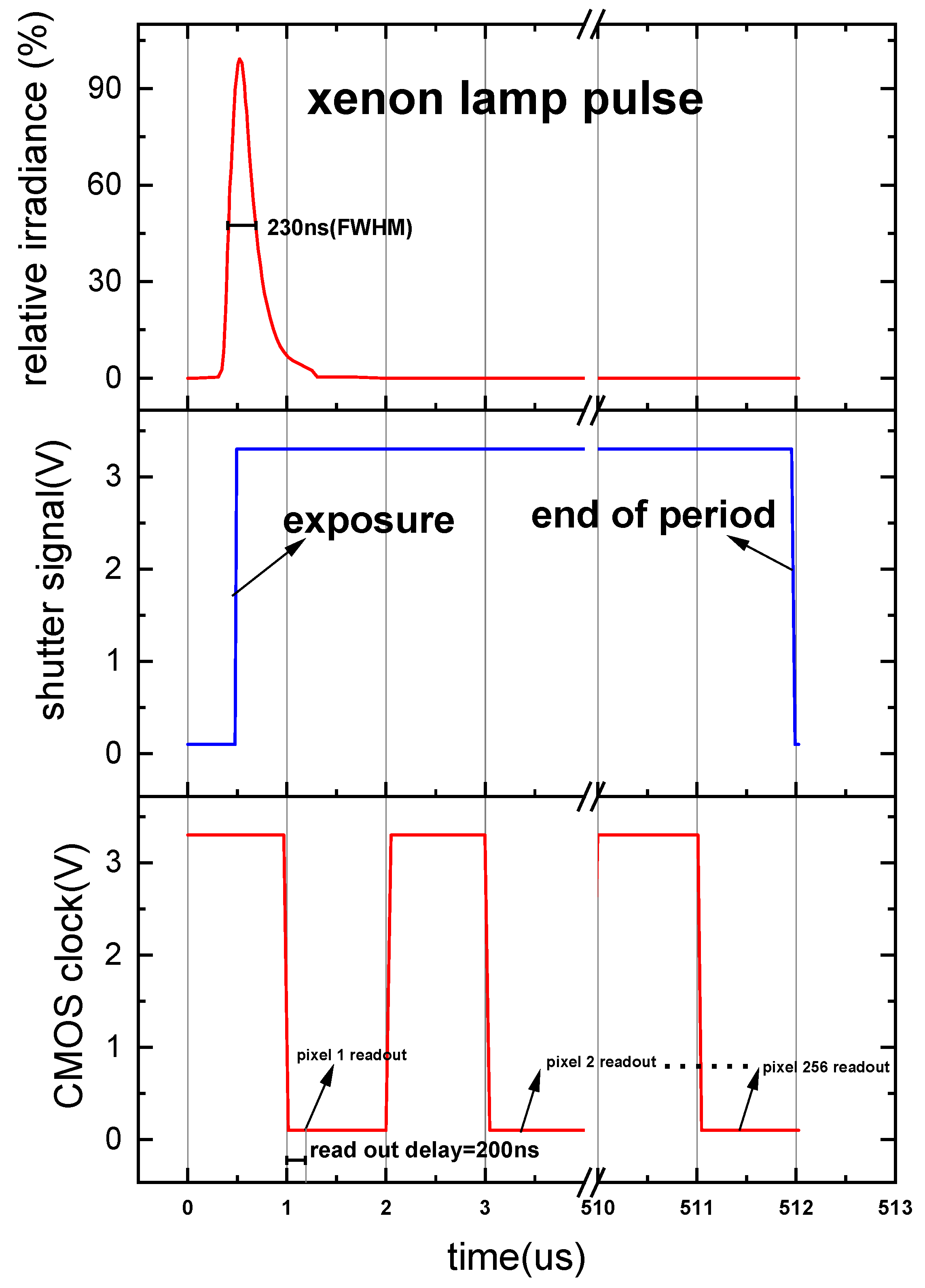


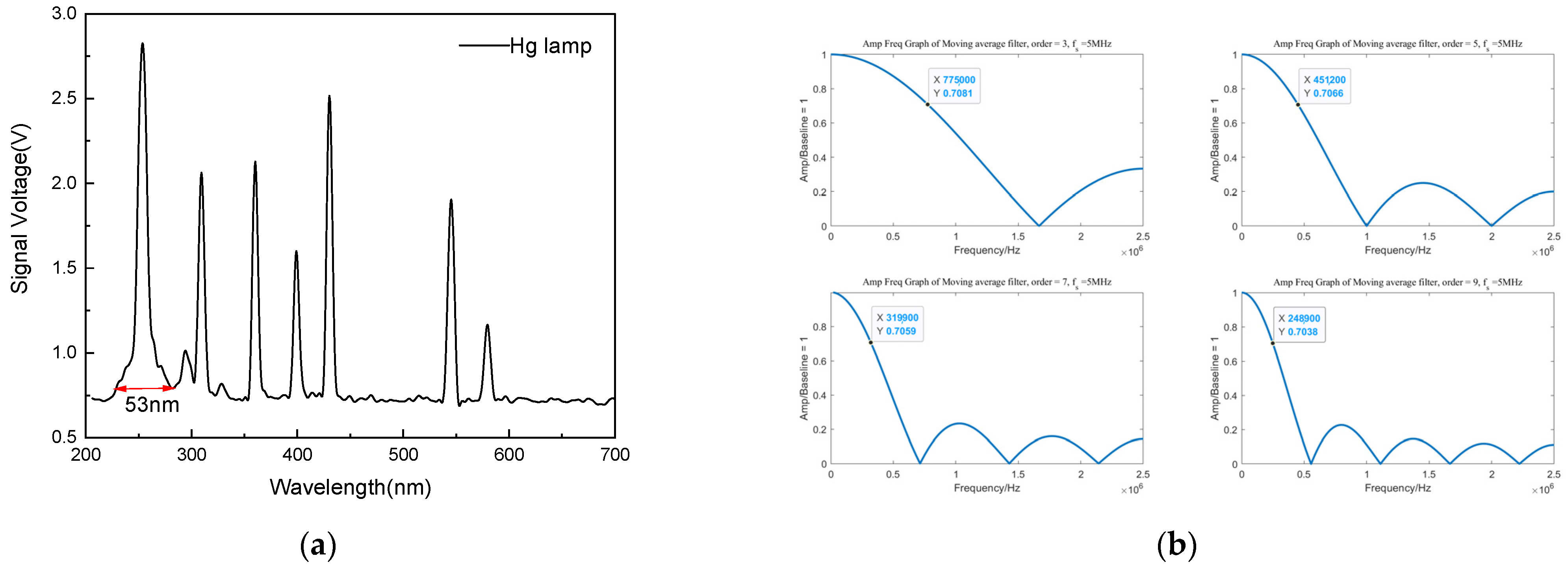
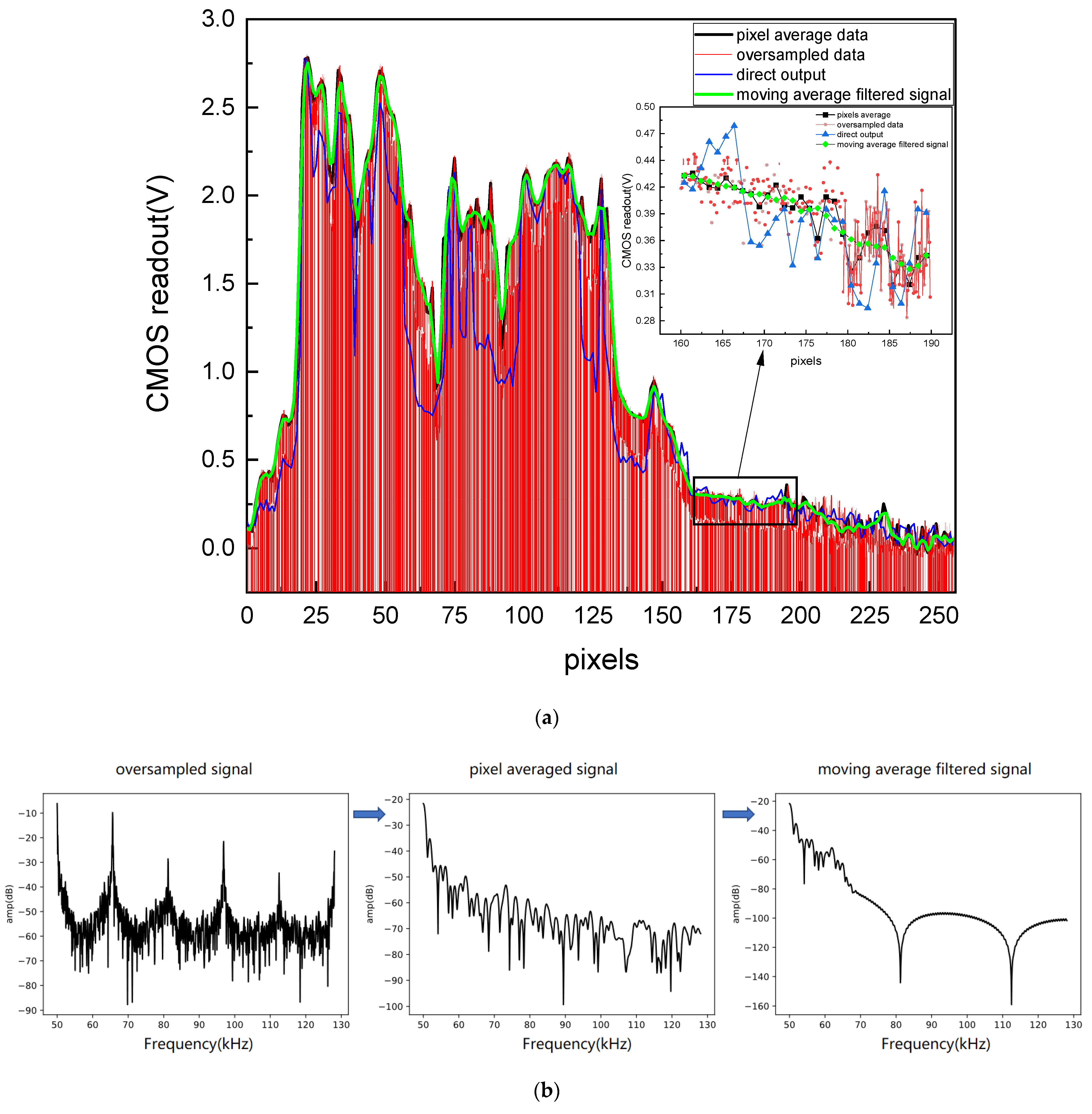


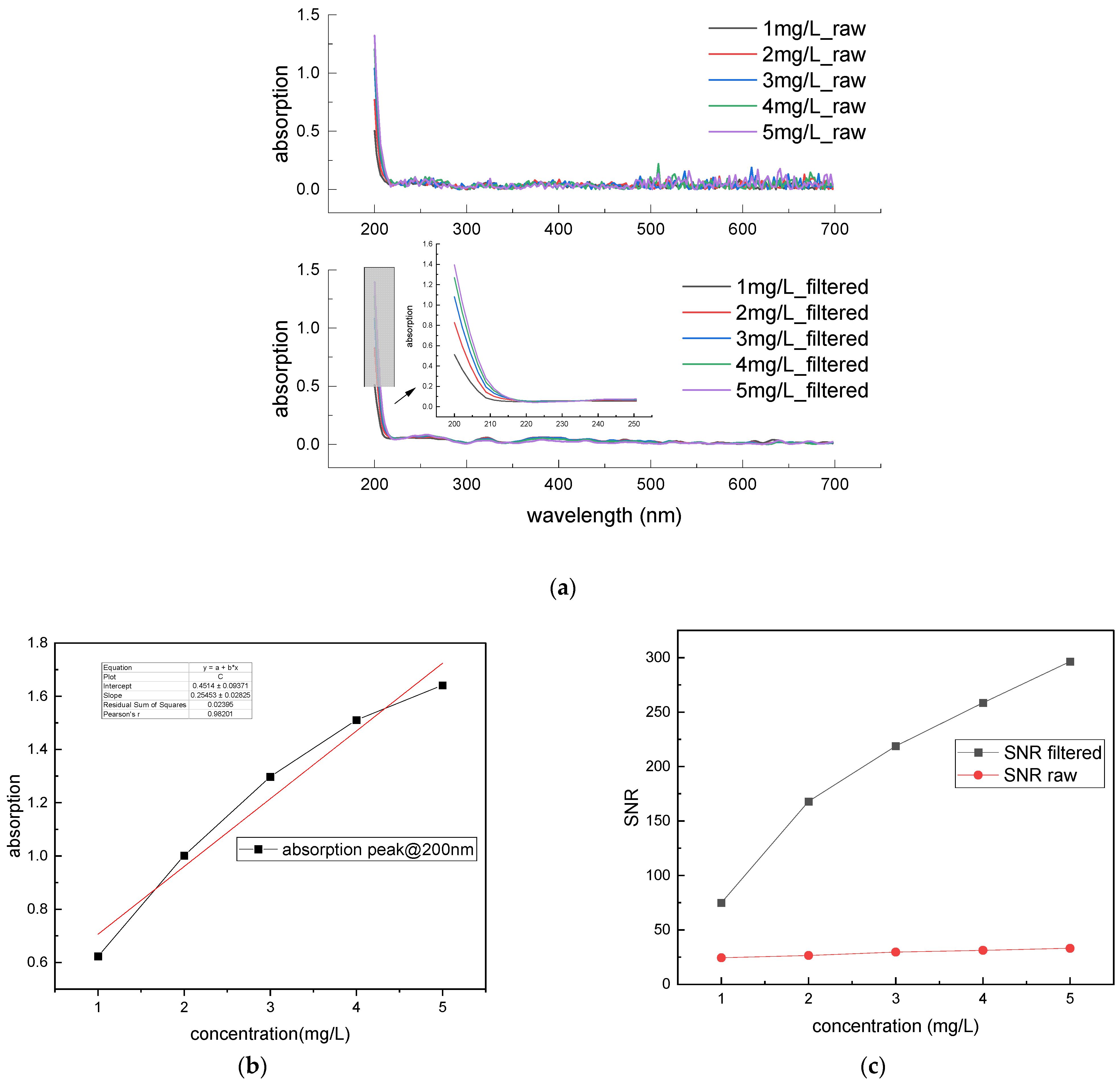

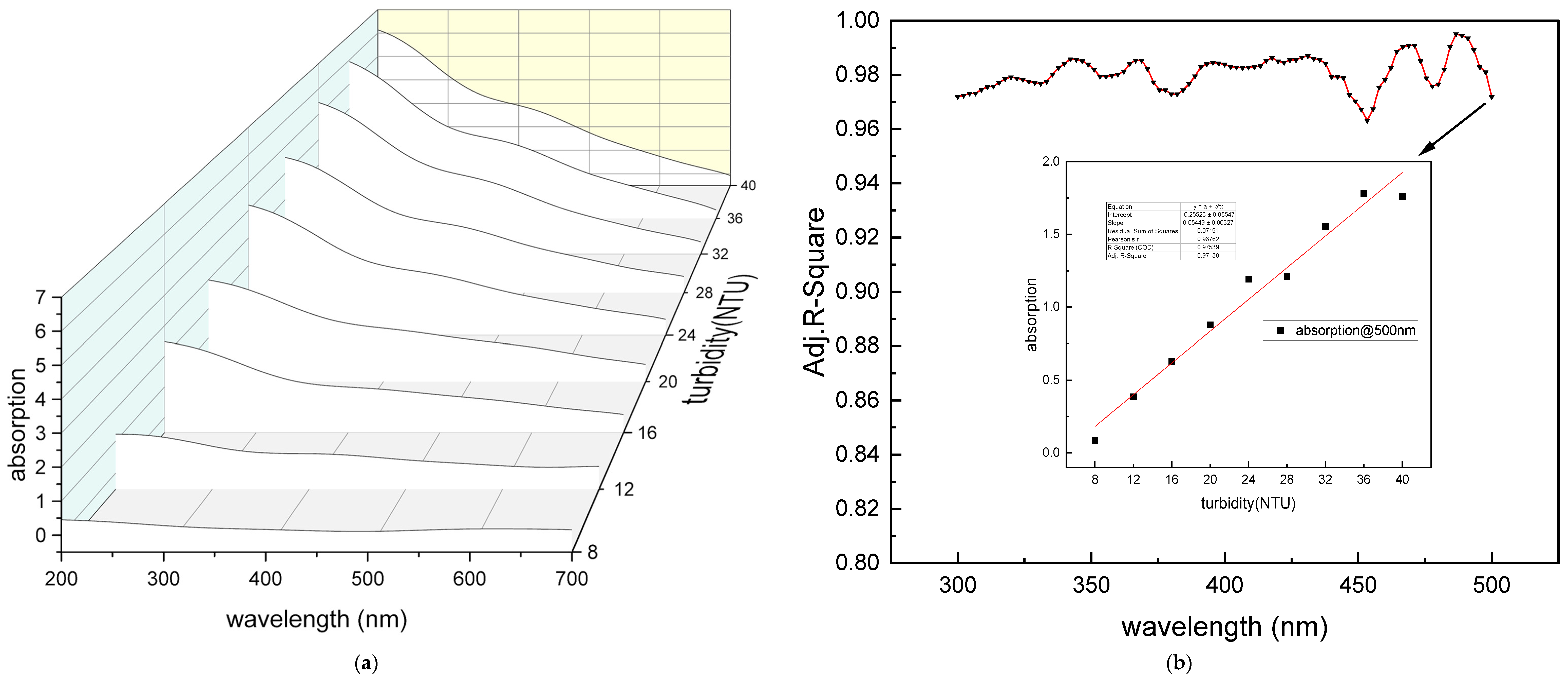
| Device | Logic Cell Usage | Memory Bit Usage | DSP48 | Fmax (MHz) |
|---|---|---|---|---|
| Spartan-6 XC6SLX16-2 | 2125 | 32K | 4 | 400 |
| On-Chip | Clocks | Logic | Signals | BRAMs | DSPs |
|---|---|---|---|---|---|
| Power(W) | 0.017 | 0.004 | 0.013 | 0.002 | 0.000 |
| On-chip | PLLs | IOs | Leakage | Total | |
| Power(W) | 0.102 | 0.001 | 0.023 | 0.162 |
| Concentration (mg/L) | Filtered RMSE | Filtered Absorption Peak | Filtered SNR | Raw RMSE | Raw Absorption Peak | Raw SNR |
|---|---|---|---|---|---|---|
| 1 | 0.00833 | 0.62 | 74.83 | 0.0207 | 0.50 | 24.32 |
| 2 | 0.00596 | 1.00 | 167.99 | 0.0291 | 0.77 | 26.46 |
| 3 | 0.00593 | 1.30 | 218.78 | 0.0351 | 1.04 | 29.65 |
| 4 | 0.00584 | 1.51 | 258.49 | 0.0385 | 1.20 | 31.26 |
| 5 | 0.0055 | 1.64 | 296.39 | 0.0428 | 1.42 | 33.13 |
Publisher’s Note: MDPI stays neutral with regard to jurisdictional claims in published maps and institutional affiliations. |
© 2022 by the authors. Licensee MDPI, Basel, Switzerland. This article is an open access article distributed under the terms and conditions of the Creative Commons Attribution (CC BY) license (https://creativecommons.org/licenses/by/4.0/).
Share and Cite
Xia, M.; Zhao, N.; Yin, G.; Yang, R.; Chen, X.; Feng, C.; Dong, M. A Design of Real-Time Data Acquisition and Processing System for Nanosecond Ultraviolet-Visible Absorption Spectrum Detection. Chemosensors 2022, 10, 282. https://doi.org/10.3390/chemosensors10070282
Xia M, Zhao N, Yin G, Yang R, Chen X, Feng C, Dong M. A Design of Real-Time Data Acquisition and Processing System for Nanosecond Ultraviolet-Visible Absorption Spectrum Detection. Chemosensors. 2022; 10(7):282. https://doi.org/10.3390/chemosensors10070282
Chicago/Turabian StyleXia, Meng, Nanjing Zhao, Gaofang Yin, Ruifang Yang, Xiaowei Chen, Chun Feng, and Ming Dong. 2022. "A Design of Real-Time Data Acquisition and Processing System for Nanosecond Ultraviolet-Visible Absorption Spectrum Detection" Chemosensors 10, no. 7: 282. https://doi.org/10.3390/chemosensors10070282
APA StyleXia, M., Zhao, N., Yin, G., Yang, R., Chen, X., Feng, C., & Dong, M. (2022). A Design of Real-Time Data Acquisition and Processing System for Nanosecond Ultraviolet-Visible Absorption Spectrum Detection. Chemosensors, 10(7), 282. https://doi.org/10.3390/chemosensors10070282






